Introduction
Myth, history, and magnificence – the Hanging Gardens of Babylon tread the fine line between all these avenues to emerge as one of Herodotus’ Seven Wonders of the Ancient World. And while the name itself evokes a reverie of a colossal construction with lush greenery accompanied by the kaleidoscopic bevy of flowers and herbs, unfortunately, there is very little archaeological evidence to support the presumed massive scale of these fabled Hanging Gardens from ancient Mesopotamia.
Contents
A ‘Wondrous’ Gift of the Ancient World
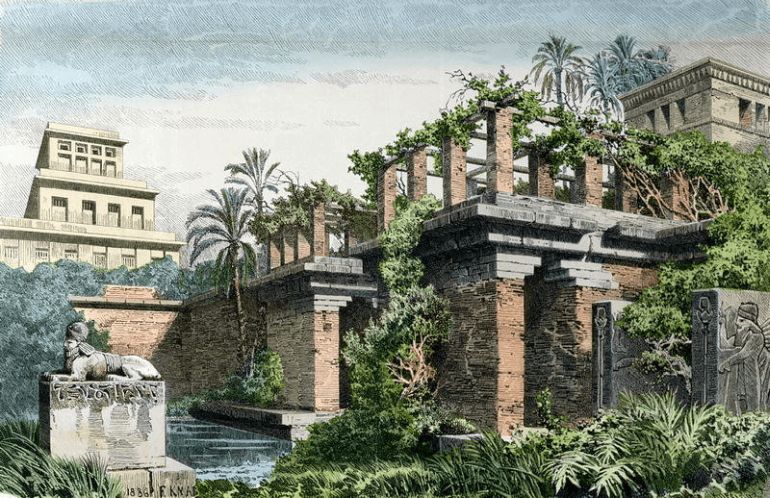
Given the nigh-mythical status of the Hanging Gardens of Babylon, we hark back to one particular legend that talks about how Babylonian king Nebuchadnezzar II may have constructed the gardens in the 6th century BC, as a gift to his queen Amytis. It should be noted that during this time period, the city was the jewel of the ascendant Neo-Babylonian Empire.
Now, beyond the gargantuan nature of this ‘gift’, it was the thought that counted – since Amytis came from Media, the area roughly corresponding to the northwestern part of modern-day Iran. The queen was apparently homesick for the verdant valleys and mountain meadows of her native land. The king thus came up with the solution of creating a blooming ‘wonder’ for his wife in the very heartland of Mesopotamia – ancient Babylon.
Now from a historical angle, some of these legends were first described by Berossus (apparently in his book Babyloniaca), a Chaldaean priest who lived in the late 4th century BC (or 3rd century BC). Subsequently, many ancient writers (including Greek historians) also went on to provide written descriptions of this gargantuan wonder; sometimes quoting Berossus’ work and at other times paraphrasing other sources.
For example, Diodorus Siculus (the author of the famed Bibliotheca Historica) possibly consulted the 4th century BC texts of Ctesias of Cnidus, and then made this description of the ancient wonder in the 1st century BC –
There was also, beside the acropolis, the Hanging Garden, as it is called, which was built, not by Semiramis, but by a later Syrian king to please one of his concubines; for she, they say, being a Persian by race and longing for the meadows of her mountains, asked the king to imitate, through the artifice of a planted garden, the distinctive landscape of Persia.
The park extended four plethra on each side, and since the approach to the garden sloped like a hillside and the several parts of the structure rose from one another tier on tier, the appearance of the whole resembled that of a theater.
When the ascending terraces had been built, there had been constructed beneath them galleries which carried the entire weight of the planted garden and rose little by little one above the other along the approach; and the uppermost gallery, which was fifty cubits high, bore the highest surface of the park, which was made level with the circuit wall of the battlements of the city.
Furthermore, the walls, which had been constructed at great expense, were twenty-two feet thick, while the passageway between each two walls was ten feet wide. The roof above these beams had first a layer of reeds laid in great quantities of bitumen, over this two courses of baked brick bonded by cement, and as a third layer of covering of lead, to the end that the moisture from the soil might not penetrate beneath.
On all this again earth had been piled to a depth sufficient for the roots of the largest trees; and the ground, when leveled off, was thickly planted with trees of every kind that, by their great size or other charm, could give pleasure to the beholder.
And since the galleries, each projecting beyond another, all received the light, they contained many royal lodgings of every description; and there was one gallery which contained openings leading from the topmost surface and machines for supplying the gardens with water, the machines raising the water in great abundance from the river, although no one outside could see it being done. Now this park, as I have said, was a later construction.
The Incredible Feat of Ancient Engineering
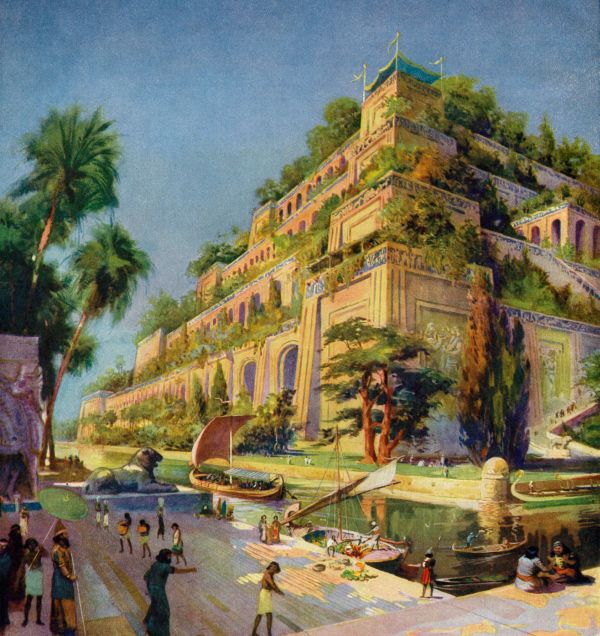
However, as we mentioned before, beyond ancient descriptions, there is very little actual physical evidence to support the notion of a giant structural garden by the banks of the river Euphrates. And if we take the route of conjecture, the elusive world wonder was possibly built (if it was built at all) to replicate a mountain with an array of terraced gardens.
And as we can discern from Siculus’ description – the structure possibly showcased a deft arrangement of multi-storied high stone terraces, with their networks being supported by columns made of specially baked bricks (composed of a mixture of clay and straws) that were (possibly) used due to relative paucity of stone quarries in Mesopotamia.
The Babylonian engineers then would have filled up these columns, secured by bitumen mortar, in the dirt for the growth of the rich foliage of trees and plants. To that end, many scholars have pointed out how such an engineering feat would have required an entire irrigation system of pumps, cisterns, and shadufs (an ancient water-lifting device operated manually) – so as to transport precious water from the nearby Euphrates River to the top of the gardens.
And over time, the nourishment (and growth) of these multifarious fauna specimens would have allowed them to be suspended from the variant levels, thus presenting fascinating facades of an artificial mountaintop with blossoming flowers and lush hanging greenery.
Siculus also mentions the use of stone slabs as platforms that were draped in layers of reed, asphalt, and tiles. These were possibly done to negate the dampness of water affecting the bricks of the supporting columns.
The Scant Evidence of the Hanging Gardens
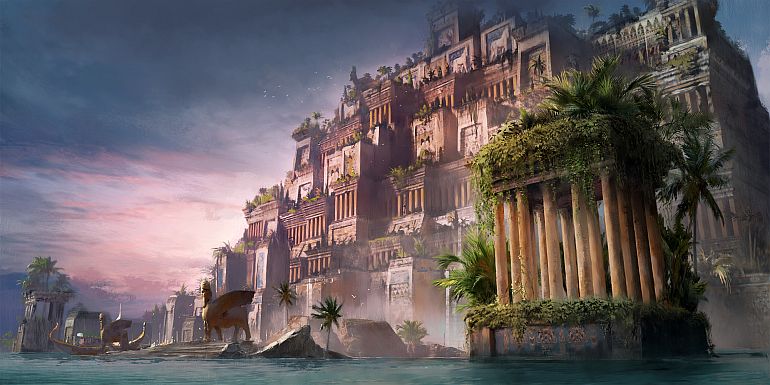
Now keeping these constructional conjectures aside, archaeologists have actually come across a palatial complex inside Babylon that had its fair share of vaults and wells. But the location of this seemingly monumental structure is not close to the banks of the Euphrates, which rather contradicts the descriptions of ancient Greek authors. Moreover, these large segments were possibly part of huge storerooms for the thriving ancient city.
On the other hand, researchers have also discovered ruins of 82-ft wide wall overlays with connected drains by the banks of the river. And while this alludes to the possibility of a substantially large structure that was built during ancient times, unfortunately, none of these ruins directly point to the actual existence of the incredible Hanging Gardens of Babylon.
But arguably, the most damning case for the Hanging Gardens of Babylon comes from the literary works (or lack thereof) of the then-contemporary Babylonian realm. To that end, historians have not found a single source that mentions the existence of the ancient wonder. This is in stark contrast to the ample literary coverage showered upon the other infrastructural and architectural achievements of King Nebuchadnezzar II.
This has led to one conjecture relating to how Berossus, who was himself also a priest of Marduk, ‘invented’ the Hanging Gardens of Babylon for political reasons. During his lifetime, Babylon was already captured by the Hellenistic armies of Alexander. Moreover, he may have also been inspired by the legends of other monumental gardens.
Finally, there is also a scant chance that the actual remains of the Hanging Gardens of Babylon are possibly submerged beneath the Euphrates River. In that regard, it should be noted that the water ran east of its current course during ancient times. As a result, the western section of ancient Babylon has not been excavated fully.
The Hanging Gardens of Nineveh
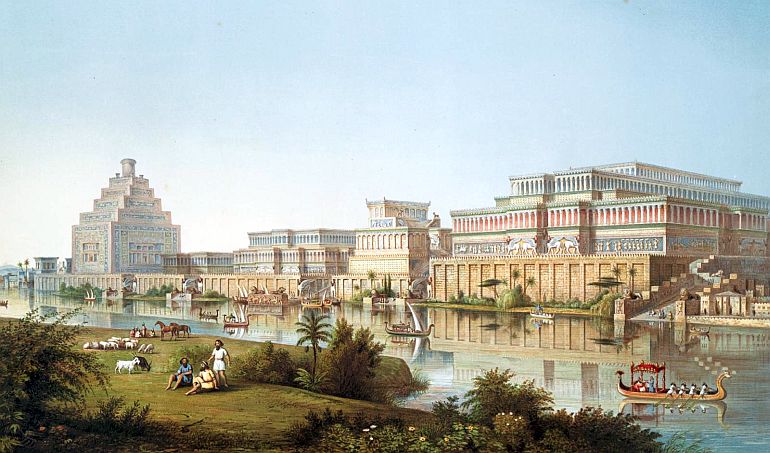
In yet another twist to the tale, according to Dr. Stephanie Dalley, an honorary research fellow of the Oriental Institute at Oxford University, the Hanging Gardens of the ancient world were real. But the researcher asserts that the entire monumental scope, with its lush vegetation and exotic plants, was not even located in Babylon.
Stephanie Dalley made a comparative analysis of quite a few ancient texts in cuneiform. She concluded that the Hanging Gardens were constructed in the early 7th century BC, 300 miles north of Babylon, in the Assyrian royal city of Nineveh.
Some of the translations allude to Assyrian king Sennacherib as the one who might have commanded the construction of the massive building project for his own palatial complex. Few texts with the Assyrian angle also mentioned the use of water-raising screws made of bronze that might have functioned in a similar manner to the renowned Archimedes Screw.
As for the archaeological perspective for this hypothesis, researchers have come across ruins of an impressive aqueduct system surrounding Nineveh (near present-day Mosul) that was used for delivering water from the mountains. The scope is further complemented by pictorial depictions in the bas-relief (circa 7th century) inside the Royal Palace of Ashurbanipal that portrays a verdant garden (with arches embellished with hanging plants) being watered by this aqueduct.
And beyond just inscriptions, there is a practicality to consider. To that end, the mountainous terrain surrounding Nineveh would have made it easier to transport water (by level differences) as opposed to the plains of Babylon. According to Dalley’s research, the ‘Hanging Gardens of Nineveh’ were probably constructed by stacking a series of terraces, like an amphitheater, that finally culminated in an artificial lake at the bottom.
Satellite photos have shown the remnants of a similar structure in the proximate location which is around 300 ft wide and 60 ft deep at various sections. In essence, the majority of the academic world is convinced of the lush gardens of ancient Nineveh – the very stronghold of the Assyrian Empire, one of the first superpowers of the ancient world.
Conclusion – Fable or Reality?
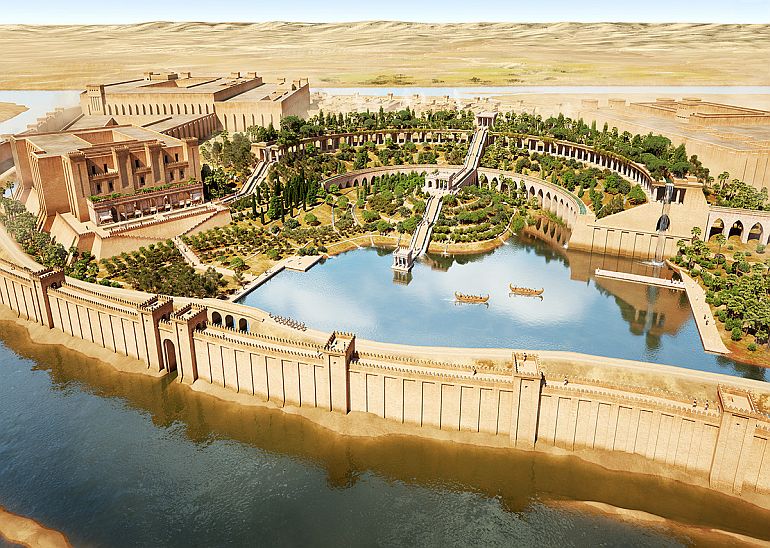
Now in spite of such findings, the question naturally arises – how did so many ancient authors confuse Nineveh with Babylon? In that regard, Dalley mentions how after conquering Babylon in 689 BC, the Assyrians named their own royal city of Nineveh ‘New Babylon’ (or ‘Old Babylon’ in some sources). For example, even the city gates of Nineveh were named after Babylon’s entrances, thus mirroring the revered cultural heritage of ancient Babylon.
This could have created an etymological error in translation since the first account of the Hanging Gardens was only written centuries after its presumed construction date. Furthermore, there are literary sources that mention the presence of other ancient monumental gardens in proximate realms, including the Middle East, India, and China.
One prime example would pertain to the Royal Garden of Pasargadae – the first founding capital of the Persian Empire under Cyrus the Great. Archaeological evidence, accompanied by recent aerial and geophysical surveys, has shed light on the massive scale of such gardens in Persia.
In conclusion, while there is no physical evidence for the Hanging Gardens of Babylon, we can’t simply write off the presence of such a structure (or a similar architectural complex) – especially, since there are some parts of the city that have not been fully excavated fully.
However, as mentioned before, the more elusive nature of the ancient wonder comes from a lack of appropriate native sources. This does allude to how the Hanging Gardens were possibly the ‘romanticized’ combination of legends and inspirations from other near-contemporary gardens.
Reconstruction of the Hanging Gardens of Babylon
In any case, the folks over at Lumion 3D have given a go at virtually reconstructing this nigh mythical monument from antiquity – and the results are quite breathtaking, to say the least (albeit with a few artistic licenses).
Researchers over at the University of Northampton have also created a short reconstruction of the presumably grand garden complex –
And finally, another GIF from Budget Direct also reconstructs the most elusive among the seven ancient wonders in a prim manner –
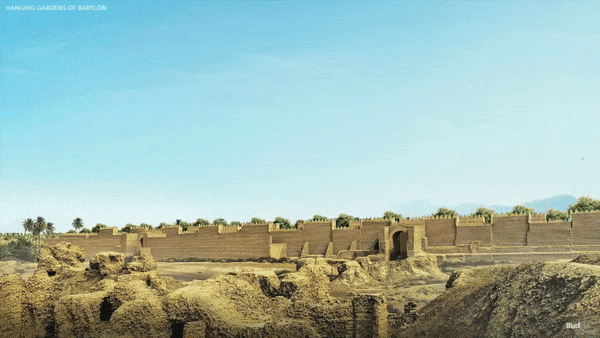
Video Source: YouTube
Sources (for the article): AncientEncyclopedia / UNMuseum
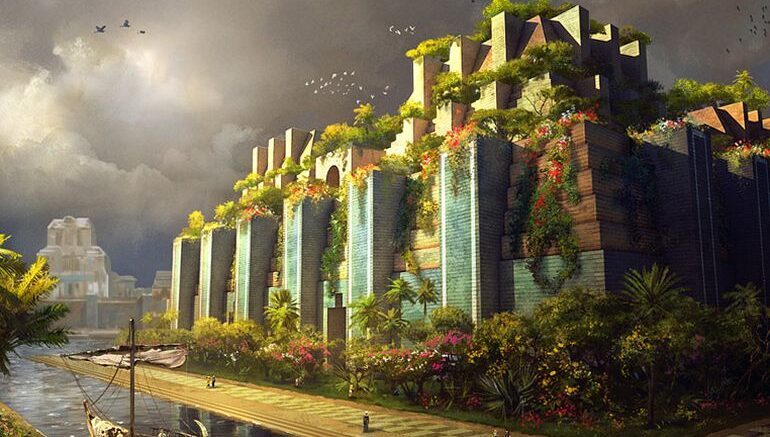




Be the first to comment on "The Fabled Hanging Gardens of Babylon: History And Reconstruction"